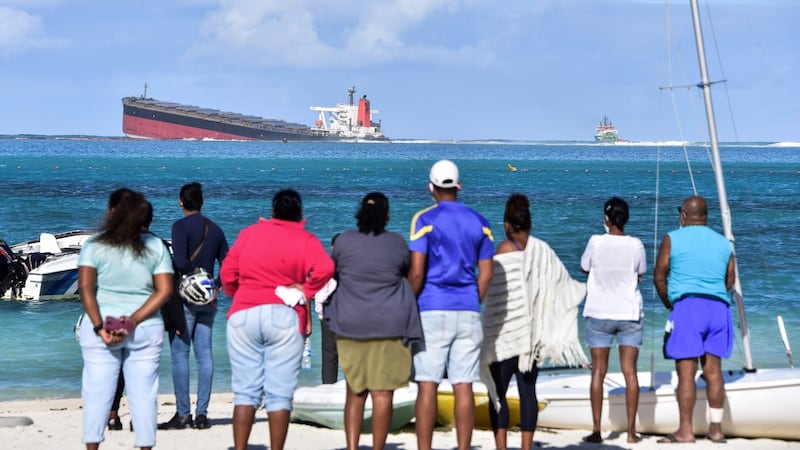A ship that ran aground off the shores of Mauritius, in the Indian Ocean, began spilling oil into the country's famed blue lagoons this week, triggering an environmental crisis in a tiny island nation that relies on its waters for fishing and tourism.
The hull of the Wakashio, a Japanese-owned and Panama-flagged bulk carrier, was found to be cracked Thursday, Mauritian authorities said, 12 days after the ship became grounded off the island’s southeastern coast with nearly 4,000 tons of fuel oil and 200 tons of diesel on board.
As the spill has expanded into the clear blue waters of nearby lagoons, the Mauritian environment minister, Kavydass Ramano, said at a news conference Thursday that the country faced an unprecedented environmental crisis. The nation relies on its pristine lagoons for tourism and food.

"This is the first time that we are faced with a catastrophe of this kind, and we are insufficiently equipped to handle this problem," said Sudheer Maudhoo, the fishing minister. The island of Mauritius, over 1,200 miles off Africa's eastern coast, is home to 1.3 million people, and the tropical forests, dozens of miles of sandy beaches and mountains that dot its territory have long made it a famed sea-diving and tourism destination. The national territory also includes several smaller islands.
Ecological crisis
Mauritius welcomed nearly 1.4 million visitors in 2019, according to data provided by its ministry of tourism. But the nation, home to many rare or endangered species, has struggled to attract tourists this year amid the coronavirus pandemic, and environmental groups have warned that it is now facing one of its most serious ecological crises.
Happy Khambule, a senior climate and energy campaign manager at Greenpeace, said thousands of species in the lagoons were at risk. “Once again we see the risks in oil,” Khambule said in a statement, enumerating them as “aggravating the climate crisis, as well as devastating oceans and biodiversity and threatening local livelihoods around some of Africa’s most precious lagoons.”
Over 400 booms have been deployed to contain the spill, with measured success so far. An 11-person team also tried to secure and stabilise the ship, authorities said Thursday, but had to be evacuated because the cracks in the hull were deemed too dangerous.
Authorities have ordered fishermen to clear the area and people to stay away from the beaches and lagoons of Blue Bay, Pointe d’Esny and Mahebourg as the spill spreads. Nearly a dozen schools in coastal areas were closed Friday, and classes will be suspended until early next week, authorities have said.
Grounded
The Wakashio, a 984-foot-long vessel built in 2007, according to tracking service Marine Traffic, was on its way to Brazil from China when it was grounded on July 25th near Pointe d'Esny, more than one mile off the shore of Mauritius. The crew was rescued, and the ship remained at sea for nearly two weeks, as authorities deployed a 550-yard-long fence around the vessel and hundreds of booms. They initially said no spill had been detected.

But Thursday, the environment ministry said in a statement that a leak had appeared, and images shared on social media and by local news outlets showed a dark oily substance spilling from a crack in the vessel’s hull. The company that owns the Wakashio, Nagashiki Shipping, said in a statement that “bad weather and constant pounding” had breached the hull and promised “to protect the marine environment and prevent further pollution.” It was unclear whether the company planned to pay for cleaning efforts or offer compensation for damages. A company representative did not immediately reply to a request for comment.
An oil spill in Russia this year had catastrophic environmental consequences. More than 20,000 tons of diesel leaked into a river in northeastern Siberia, one of the biggest oil spills in modern Russian history. And off the coast of Yemen, a decaying supertanker risks spilling 1 million barrels of crude oil into the Red Sea if it is not secured, the United Nations has warned.











